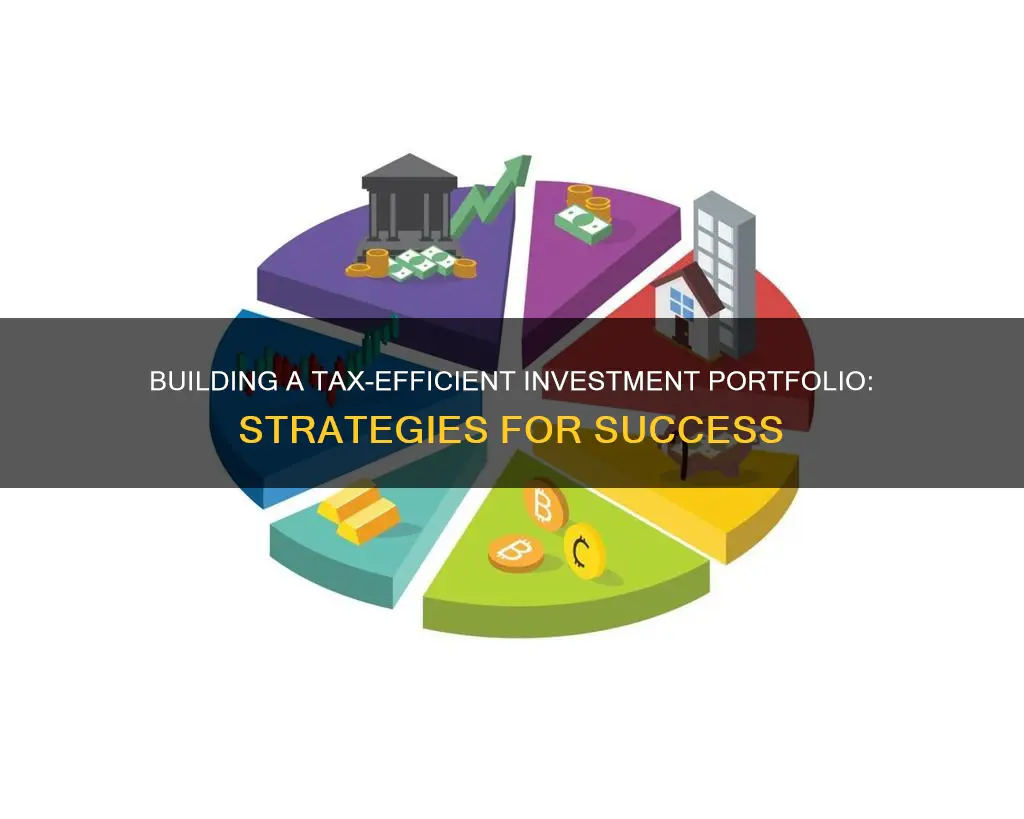
Building a taxable investment portfolio is a challenging task, but it can be made simpler by following a few steps. Firstly, it is important to understand your financial goals and time horizon. Are you investing for the short, medium, or long term? This will help determine the level of risk you are willing to take. Next, assess your risk tolerance – how much are you willing to lose to achieve your goals? This will influence the types of investments you make. You can then choose an account type that aligns with your goals, such as a tax-advantaged account like an IRA or 401(k) for long-term goals, or a taxable brokerage account for mid- to long-term goals. When selecting investments, consider stocks, bonds, mutual funds, exchange-traded funds (ETFs), or alternative investments like real estate or cryptocurrencies. Diversify your portfolio to balance risk and reward. Monitor and adjust your portfolio regularly, and rebalance it when necessary to stay aligned with your goals. Finally, remember that taxable accounts will incur taxes on any gains, so try to make your portfolio as tax-efficient as possible.
| Characteristics | Values |
|---|---|
| Investment types | Stocks, bonds, mutual funds, exchange-traded funds (ETFs), real estate, cryptocurrencies, hedge funds, commodities, cash and cash alternatives, peer-to-peer lending, cash value life insurance, etc. |
| Investment accounts | Taxable accounts (e.g. brokerage accounts), tax-advantaged accounts (e.g. IRAs, 401(k)s) |
| Investment goals | Short-term, medium-term, long-term |
| Risk tolerance | Aggressive, moderate, conservative |
| Time horizon | Short-term (less than a year), medium-term (1-5 years), long-term (more than 5 years) |
| Tax efficiency | Tax-efficient investments include ETFs, individual stocks, municipal bonds, treasury bonds, Series I bonds; tax-inefficient investments include high-yield bonds, actively traded mutual funds, real estate investment trusts, high-dividend stocks, corporate bonds |
What You'll Learn

Exchange-traded funds (ETFs)
ETFs are taxed when they are sold and capital gains are incurred. There are a few things to keep in mind when it comes to ETF taxation:
- Capital Gains Taxes: ETFs rarely pay out capital gains as they are structured to minimise in-fund capital gains events. However, investors who sell an ETF and realise a capital gain will be subject to capital gains tax. The tax rates on long-term capital gains range from 0% to 20%, depending on the investor's taxable income.
- Taxation of Dividends: ETF dividends are taxed based on how long the investor has owned the fund. If held for more than 60 days, the dividend is considered a "qualified dividend" and is taxed at a lower rate. If held for less than 60 days, the dividend is taxed at the investor's ordinary income tax rate.
- International ETFs: Some international ETFs, especially those focused on emerging markets, may be less tax-efficient due to restrictions on in-kind deliveries of securities. This can result in taxable events and capital gains for investors.
- Leveraged/Inverse ETFs: These funds have been relatively tax-inefficient due to the use of derivatives and the 60/40 tax treatment, where 60% of gains are considered long-term and 40% short-term, regardless of the holding period.
When building a tax-efficient portfolio using ETFs, it is important to consider the overall investment strategy, risk tolerance, and tax obligations associated with the investments. Consulting a financial or investment professional can help individuals make informed decisions about their portfolios.
Invest Your Savings Wisely: A Guide for Nigerians
You may want to see also

Tax-loss harvesting
Here's how it works:
- You sell investments that are down, or not performing well.
- You replace those investments with reasonably similar ones.
- You use the losses from the sale to offset any investment gains, reducing the taxes you pay on those gains.
- If your capital losses are greater than your capital gains, you can deduct up to $3,000 per year from your taxable income ($1,500 if married filing separately).
- Any remaining losses can be carried forward to future years and deducted from your taxes then.
There are a few important things to keep in mind when considering tax-loss harvesting:
- It only applies to investments held in taxable accounts, not tax-sheltered accounts like 401(k)s or IRAs.
- It is most useful if you invest in individual stocks, actively managed funds, or exchange-traded funds (ETFs).
- You need to be mindful of the wash-sale rule, which states that you cannot buy the same or a substantially similar security within 30 days before or after the sale.
- Don't sell investments just for the tax break. Consider the overall investment strategy and your goals.
- Work with a financial advisor or tax professional to ensure you're following the rules and optimising your portfolio.
Investment-led Savings: The Economy's Driving Force
You may want to see also

Tax-deferred accounts
There are various types of tax-deferred investment accounts, each with its own unique features and benefits:
Employer-Sponsored Retirement Plans
These include 401(k)s, 403(b)s, and 457 plans, which offer both tax-deferred compounding and pre-tax contributions. Many employers also offer matching contributions, making this a popular option for those looking to take advantage of tax-deferred investments.
Traditional and Roth IRAs
Traditional IRAs may allow pre-tax contributions depending on your income level and other factors. On the other hand, Roth IRAs do not offer pre-tax contributions but can be tax-free if certain conditions are met.
Fixed Deferred and Variable Annuities
Annuities are insurance products that provide a death benefit and other guarantees. They can be structured as fixed or variable, offering different levels of flexibility and benefits. Annuities are a good option for those who want to ensure their beneficiaries are protected.
Whole Life Insurance
Whole life insurance is a type of permanent life insurance policy that lasts for the entirety of your life, as long as you pay the regular premiums. A portion of these premium payments goes towards a cash value component that builds up over time without being taxed, making it tax-deferred. Whole life insurance can be a good source of emergency funds due to its tax-advantaged growth.
Series I and Series EE Savings Bonds
These are low-risk, non-marketable, and interest-bearing savings products offered by the government. The interest accrued on these bonds is tax-deferred until they are cashed in, providing a tax-advantaged way to save for the long term.
Tax-deferred investments are particularly attractive to those in high tax brackets who expect to be in a lower tax bracket upon retirement. By investing in tax-deferred accounts, they can benefit from the tax-free growth of earnings and potentially substantial tax savings upon withdrawal during retirement.
Public Saving and Investment: Two Sides of the Same Coin?
You may want to see also

Taxable accounts
When you sell an asset you have held for a year or less, your gain is taxed at your marginal rate. If you sell an asset held for more than a year, your gain is taxed at a special, lower rate. Some investment income is taxed at your marginal rate, regardless of how long you have held the asset. Interest earned from bond investments (except municipal bonds), P2P lending, and cash products are taxed at your marginal rate, no matter the situation.
When building a taxable investment portfolio, you can invest in stocks and/or mutual funds. You can also consider dividend stocks that pay out regularly, on top of the chance of capital appreciation. If you are worried about individual stock-picking, you can invest in mutual funds (including index funds) or exchange-traded funds (ETFs).
Municipal bonds are quite tax-efficient. The federal government doesn't collect taxes on "muni" bond interest earnings, and some states won't charge you income tax if you are a resident of the state you are buying bonds in.
You can also invest in small businesses and real estate, though these investments come with their own risks, and you usually need quite a bit of capital.
Savings vs Investments: When Does Saving Trump Spending?
You may want to see also

Tax-advantaged accounts
Tax-Deferred Accounts
Tax-deferred accounts, such as traditional IRAs and 401(k) plans, provide an upfront tax break. Investors pay taxes when they withdraw their money in retirement, which means the tax is deferred. This type of account is best for both high-income earners and tax-inefficient investments. Contributions to these accounts can be deducted from tax returns, lowering the amount of annual taxable income.
Tax-Exempt Accounts
Tax-exempt accounts, including Roth IRAs and Roth 401(k)s, are also tax-free. Contributions to these plans are made with after-tax dollars, but investments grow tax-free, and qualified withdrawals in retirement are tax-free. These accounts have restrictions and penalties if individuals are below the retirement age when they withdraw.
There are several types of tax-advantaged accounts and investments to consider:
- Municipal bonds and bond funds: Municipal bonds aren't subject to federal income tax and may be exempt from state or local taxes if you live in the state, city, or locality where the bond was issued.
- Treasury securities: Treasury securities, such as Treasury Bills and Treasury Bonds, incur federal taxes but are exempt from state and local taxes.
- Funds designed to minimize taxes: Some funds aim to minimize taxes by employing strategies such as holding stocks for more than a year, practicing tax-loss harvesting, and avoiding investing in ordinary dividend-paying stocks.
- Stocks or mutual funds that pay qualified dividends: Qualified dividends are taxed as capital gains, while ordinary dividends are taxed as income. Investments held for more than a year are subject to the long-term capital gains tax rate, which is generally more favorable for most investors than income tax rates.
- I bonds: Issued by the US government, these aren't subject to state or local income tax but are subject to federal tax.
- Index funds: As index funds aren't actively managed mutual funds, they may not generate as many capital gains, making them more tax-efficient.
- Exchange-traded funds (ETFs): Like index funds, ETFs are passively managed, making them more tax-efficient than actively managed mutual funds. ETFs are also structured in a way that doesn't generate capital gains taxes when securities are bought and sold. Investors pay capital gains tax when they sell shares.
Tax-Efficient Asset Location
Where you choose to invest can also help minimize taxes. This strategy is known as asset location. Growth stocks with the potential to increase significantly over the years may be best purchased through a Roth or traditional IRA, while municipal bonds, which offer tax-free cash flow for federal income tax purposes, would make more sense in a non-tax-advantaged account.
Hong Kong Savings: Best Places to Invest Your Money
You may want to see also
Frequently asked questions
A taxable investment account allows you to grow your wealth and use it without penalty before retirement. You will have more access to these funds, but you won't have the same tax benefits as retirement accounts.
Some options for building a taxable investment portfolio include stocks, mutual funds, peer-to-peer lending, municipal bonds, and cash value life insurance.
You will need to pay taxes on your portfolio earnings when you realise them. For example, when you earn interest or sell a stock at a profit, you will pay taxes on that income. It is important to understand the difference between long-term and short-term capital gains, as the taxes on these vary.







